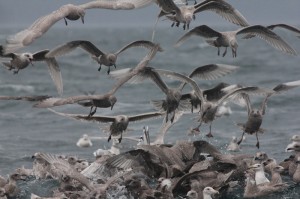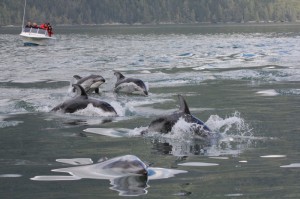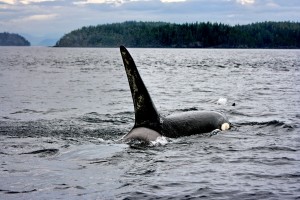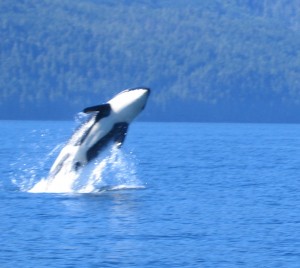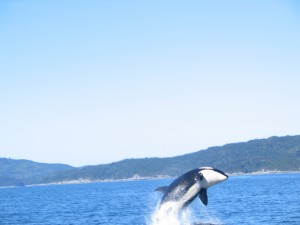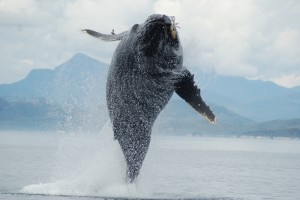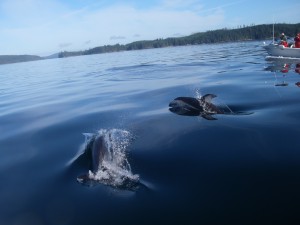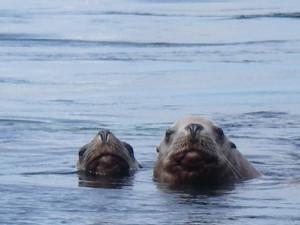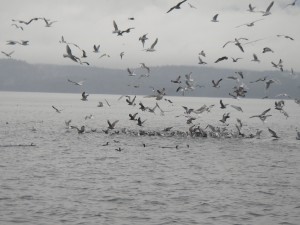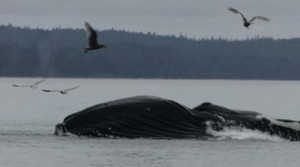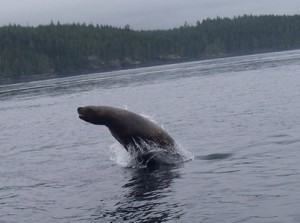A herring “ball” results when a school of herring is chased to the surface by a predatory fish, ducks or other diving birds. Often the herring balls can be spotted by a large flock of seagulls noisily feeding on the surface. Spotting the gulls feeding is a joy for your guide as the unenviable fate of the herring is to be dinner for a larger mammal meaning humpback whales. As a guide once the herring ball is located the intent is to stop the boat in proximity of the gulls and wait. “Keep your eye on the gulls and as they lift into the air get ready for a picture of a whale lunge feeding”(see tomorrow’s blog) is the directions given to the guests while we wait. James O’Donoghue’s photo captured the mass of the gulls but not the noise they produce. The area for the lodge’s whale watching safari day is Blackfish Sound not far from Vancouver Island’s Telegraph Cove. It is an area known for the abundance of herring and thus popular for salmon fishing which also means orca that feed on the salmon.
Tag Archives: Whale Watching
Whale Watching and Pacific White-side Dolphins
I cannot think of another photo that I have posted of white-sided dolphins, which tells a more complete story than this one from James O’Donoghue. On tour days we frequently travel with another boat from the lodge when we run to Johnstone Strait near Telegraph Cove to look for whales thus the picture of one of our boats in the back ground. Notice the warm “floater” suits the guests wear while on the water. Even though this is summer it is cool on the water in the morning. Also it is easy to pick out the guide without the suit as we tend to be climatized to the weather. The most amazing aspect of the photo is the fact that it shows every stage of white sides’ “porpoise” (short term for the way dolphins come out of the water when traveling in a hurry). It shows them first breaking out of the water to clearing the water and then their returning dive. Also note the calm water surrounding the ripples indicating there are likely several hundred dolphins keeping the water churned up as they pass close to our boat.
Large Male Orca on Whale Watching Safari
The day whale watching means we travel to the area of Johnstone Strait near Telegraph Cove on Vancouver Island BC. The resident, salmon eating orca, arrive in early late June and stay through October while the transient, mammal eating orca are in the area all year. Confused? The first serious study of the orca populations in the mid-1970’s started as a summer study so when the scientist arrived in July and left in September the orca were always in the area and therefore there named resident orca. Little did they know that this was a summer feeding area as the orca followed the salmon? The transient orcas, which were in the area, spend more time in the remote inlets in the summer because there was more boat traffic. The transient orca still travel through our viewing area in the summer but this photo is of a resident as determined by the size and shape of its dorsal fin, taller and narrower at the base. Photo provide by guest Alferd Bittner.
Whale Watching day with orca breaching
These photos are not as good as my guests as I was using a small Pentax Opti 6.0 megapixels and running the boat – that is my excuse. But I remember the day in Johnstone Strait off the shore of Vancouver Island we came upon an adult orca that seemed to be teaching a younger orca about breaching. The adult would breach and in less than a minute the younger would do the same. As you can see there were no other boats in the area and this behaviour continued for fifteen or twenty minutes must have been more than a dozen sets of breaching. As a guide we experience many interesting every summer but this ranks in the top ten for me.
A Whale Watching Safari Bonus
Breaching humpback whales may occur two or three times a week but pictures are much rarer maybe once or twice a summer. In the area of Bold Head in Blackfish Sound near Telegraph Cove on Vancouver Island there are quite a few humpback whales. It is common to see six to ten whales each safari as the area has an abundance of herring, which is one of the whale’s main foods. The humpback whales arrive in late May to early June and remain in the area through October.
Pacific white-sided dolphins – Whale Watching
Pacific white-sided dolphins are only one of the many mammals often viewed on the whale watching day. Dolphins tend to travel in pods of several hundred the largest pod I have come across was between fifteen hundred and two thousand. This was in the late fall and they appeared to be heading out of the area. The pods we encounter in the summer are playful and come to our boats out of curiosity. In this case we were stationary as the dolphins were following another of our boats. At other times they will pass beneath our bow while we move along side a large pod.
Humpback Whale after lunge feeding?
It is hard to determine what happened in this photo which shows a humpback whale slowly sliding backward into the water as I was not present when the photo was taken. Lunge feeding occurs when a whale comes up suddenly under a school of herring and comes out of the water with its mouth wide open engulfing the herring and spraying water everywhere. Not mush spraying here. Not enough splash to be the remainder of a breach. My guess would be a young humpback after a less than successful lunge or maybe one that has been watching to many orca spyhopping?
Sealions on BC coast
Most days on your whale watching safari we find stellar sealions. Although most pass through this part of BC’s coast on the way to and from Alaska in the spring and fall some do stay all summer. If we eat our picnic lunch in the area around Vancouver Island’s Telegraph Cove the sea lions often come to check us out so their picture is added to the bucket list.
Humpback Whale feeding
The waters between Vancouver Island and mainland British Columbia are alive with herring, which are the staple in the food chain. The diving birds and ducks feed on the herring and forces them into “herring balls” which are a tight mass of swirling herring from the size a basketball to the size of a small boat. The duck force them to the surface where the seagulls and eagle dive into to feed. As a guide I try to locate these balls by watching the gulls, then position the boat near the gulls and wait for the humpbacks to come and feed.
Sealion porpoise?
The whale safari area around Telegraph Cove on Vancouver Island contains many strange and interesting sights. Over the years I have watched many sea lions play with the humpback whales, twice saw cougars on the beach, black bears swimming between islands but this was the first for me, a stellar sealion pretending to be a dolphin. It did about fifteen of these “breeches or porpoises” behind the boat while we were following a pod of white side dolphins on the other side of the boat.
